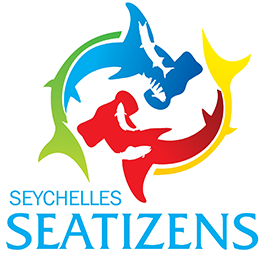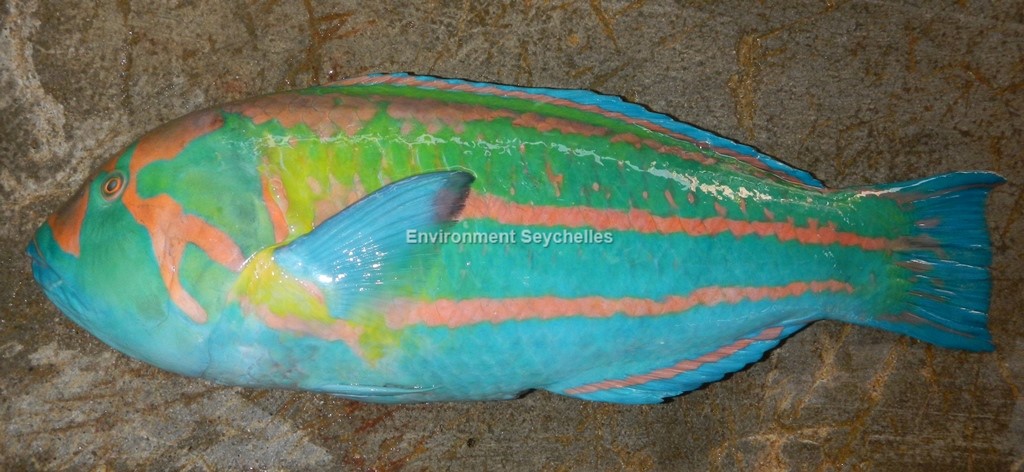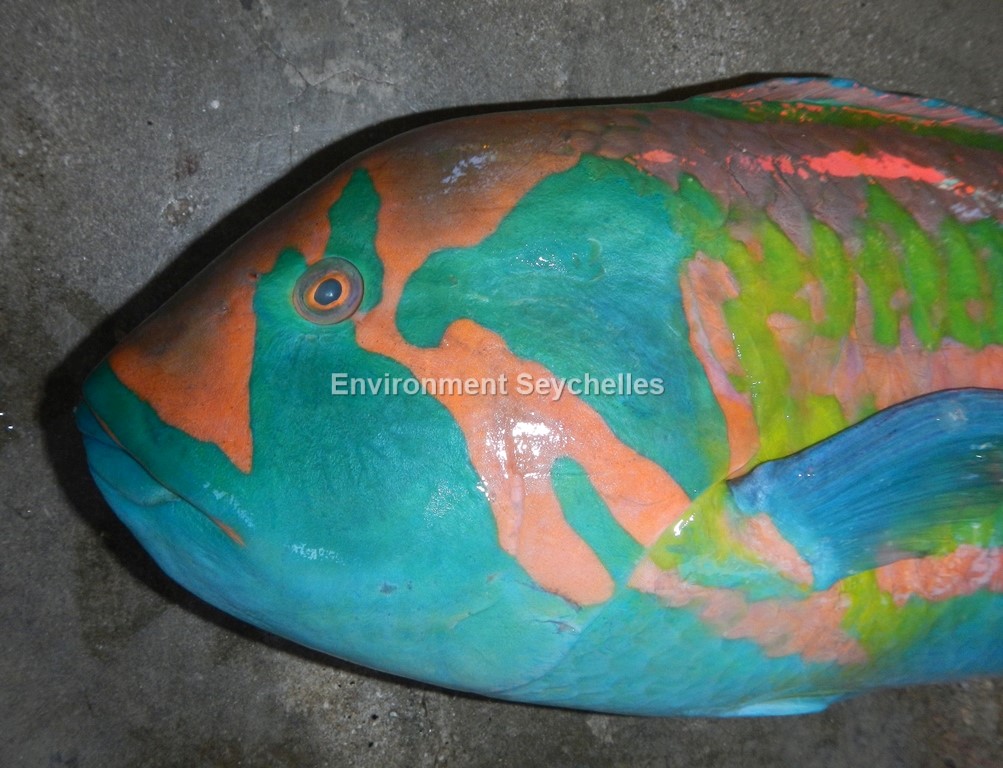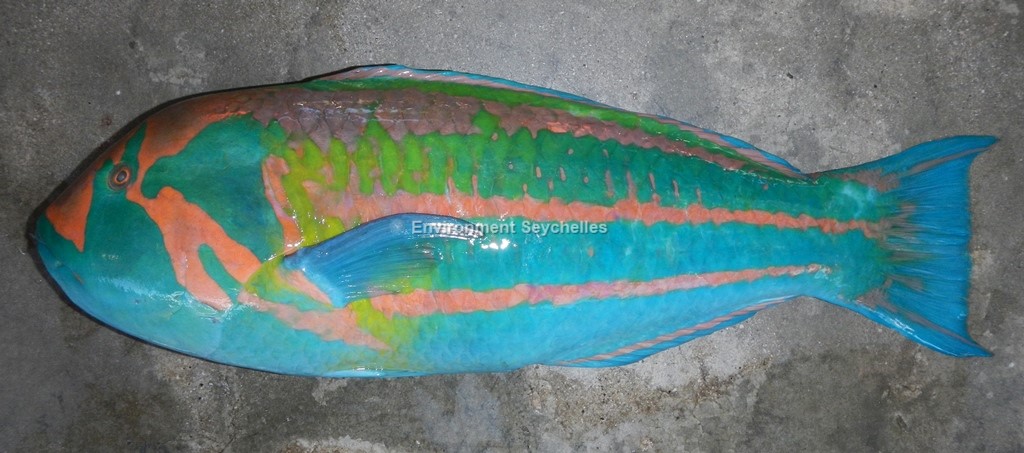Description:
Dorsal spines: 8; Dorsal rays: 12-14; Anal spines: 3; Anal rays: 10-12.
Moderately deep bodied, medium-sized wrasse. Dorsal profile of head moderately convex. Small mouth with 2 prominent canines situated anteriorly in each jaw. Dorsal fin
continuous, the anterior dorsal soft rays somewhat longer than spines. Caudal fin varies from slightly rounded in young to emarginate or double emarginate in large adults.
Colour.
Initial Phase: light red, with 2 longitudinal bands of close-set vertically elliptical or rectangular green spots on flanks. 3 longitudinal light red zones of body often
overlaid with a series of dark brown blotches. Head greenish dorsally with numerous dark reddish spots and short irregular lines, and pale orangish ventrally. Dorsal fin
orange with a longitudinal green band above middle of fin, and a black spot on first 2 interspinous membranes. Anal fin with alternating bands of salmon pink and green or
blue. Caudal fin streaked longitudinally with green and orange, the corners blue. Paired fins pale pinkish to yellowish, the base of the pectoral with a light red band.
Terminal Phase: green with 3 irregular pink stripes on body, becoming turquoise ventrally. Head turquoise with broad irregular pink bands dorsally and a broad diagonal
pink band angled posteriorly and ventrally from eye, branching at preopercle, and continuing to edge of opercle at level of lower pectoral base. Dorsal fin green at base,
with pink band and turquoise margin. Anal fin turquoise with a longitudinal pink band in lower third of fin. Paired fins turquoise.
Size:
Maturity: Lm unknown. Range unknown. Max Length: 46 cm TL.
Habitat and Ecology:
Found almost exclusively in the surge zone of outer reef flats, reef margins, and rocky coastlines (depth 0-10 m). It is a common sight for snorkelers around the coasts of
the central archipelago. Feeds upon small fishes and invertebrates including crabs, sea urchins, brittle stars, molluscs and polychaete worms. Protogynous hermaphrodite.
Males grow much larger than females. Usually occurs in groups with a dominant male, and several females and juveniles.
Fishery Status:
This species is not protected or subject to fishery regulations. It is caught occasionally by hook and line but more typically in net fisheries, regardless it is a rare
component of the catch.
Notes:
T. purpureum and T. trilobatum have nearly identical initial (female) phases and only differ slightly in coloration and length of the head. The female of T. purpureum is
best distinguished by a V-shaped mark on the snout.
References:
Bray, D.J. (2018). Thalassoma purpureum in Fishes of Australia, http://136.154.202.208/home/species/288 (14/04/20).
Cabanban, A. & Pollard, D. (2010). Thalassoma purpureum. The IUCN Red List 2010: https://dx.doi.org/10.2305/IUCN.UK.2010-4.RLTS.T187746A8618843.en. (13/04/20).
Fischer, W. & G. Bianchi (Eds) (1984). FAO species identification sheets for fishery purposes. Western Indian Ocean; (Fishing Area 51). Prepared and printed with the
support of the Danish International Development Agency (DANIDA). Rome, Food and Agricultural Organization of the United Nations, vols 1-6.
Froese, R. & D. Pauly. (Eds.) (2019). FishBase. Thalassoma purpureum https://www.fishbase.se/summary/5647 (05/06/19).
Randall, J.E. (1986). Labridae. p. 683-706. In M.M. Smith and P.C. Heemstra (eds.) Smiths' sea fishes. Springer-Verlag, Berlin.
Citation:
Nevill, J.E.G. (2019). Thalassoma purpureum, Surge wrasse. Seychelles Seatizens. www.seatizens.sc. https://seatizens.sc/species/thalassoma-purpureum-forsskal-1775/ (edited 14/07/22).




Im thankful for the article post.Really thank you! Cool.
I appreciate you sharing this post.Thanks Again. Keep writing.
Really appreciate you sharing this article.Really looking forward to read more. Cool.
Awesome blog article.Much thanks again. Fantastic.
Looking forward to reading more. Great article post.Much thanks again. Great.
Thank you ever so for you blog article.Really thank you! Want more.
Hey, thanks for the blog.Really looking forward to read more. Want more.
Fantastic blog.Thanks Again. Awesome.
Really informative post.Really looking forward to read more. Much obliged.
wow, awesome blog.Thanks Again. Much obliged.
Hey, thanks for the article. Cool.
Wow, great article post.Really thank you! Awesome.
I value the article post.Really looking forward to read more. Really Great.
Really appreciate you sharing this post.Much thanks again.
Enjoyed every bit of your blog post.Much thanks again. Cool.
I cannot thank you enough for the article.Thanks Again. Fantastic.
I am so grateful for your blog post.Thanks Again. Will read on…
Thanks for sharing, this is a fantastic post.Really thank you! Really Great.
I really liked your article.Really looking forward to read more. Really Cool.
Im obliged for the article post.Much thanks again. Want more.
This is one awesome blog article.Thanks Again. Cool.
Thanks so much for the post. Great.
Hey, thanks for the blog post.Much thanks again. Awesome.
Appreciate you sharing, great article.Really looking forward to read more. Great.
Thanks so much for the blog post.Really thank you! Keep writing.
Im thankful for the blog post.Much thanks again. Fantastic.